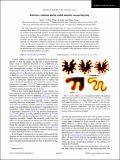Interface evolution during radial miscible viscous fingering
Author(s)
de Anna, Pietro; Juanes, Ruben; Chui, Jane Yuen Yung
DownloadPhysRevE.92.041003.pdf (3.019Mb)
PUBLISHER_POLICY
Publisher Policy
Article is made available in accordance with the publisher's policy and may be subject to US copyright law. Please refer to the publisher's site for terms of use.
Terms of use
Metadata
Show full item recordAbstract
We study experimentally the miscible radial displacement of a more viscous fluid by a less viscous one in a horizontal Hele-Shaw cell. For the range of tested injection rates and viscosity ratios we observe two regimes for the evolution of the fluid-fluid interface. At early times the interface length increases linearly with time, which is typical of the Saffman-Taylor instability for this radial configuration. However, as time increases, the interface growth slows down and scales as ~t[superscript 1/2], as one expects in a stable displacement, indicating that the overall flow instability has shut down. Surprisingly, the crossover time between these two regimes decreases with increasing injection rate. We propose a theoretical model that is consistent with our experimental results, explains the origin of this second regime, and predicts the scaling of the crossover time with injection rate and the mobility ratio. The key determinant of the observed scalings is the competition between advection and diffusion time scales at the displacement front, suggesting that our analysis can be applied to other interfacial-evolution problems such as the Rayleigh-Bénard-Darcy instability.
Date issued
2015-10Department
Massachusetts Institute of Technology. Department of Civil and Environmental EngineeringJournal
Physical Review E
Publisher
American Physical Society
Citation
Chui, Jane Y. Y., Pietro de Anna, and Ruben Juanes. “Interface Evolution During Radial Miscible Viscous Fingering.” Phys. Rev. E 92, no. 4 (October 2015). © 2015 American Physical Society
Version: Final published version
ISSN
1539-3755
1550-2376